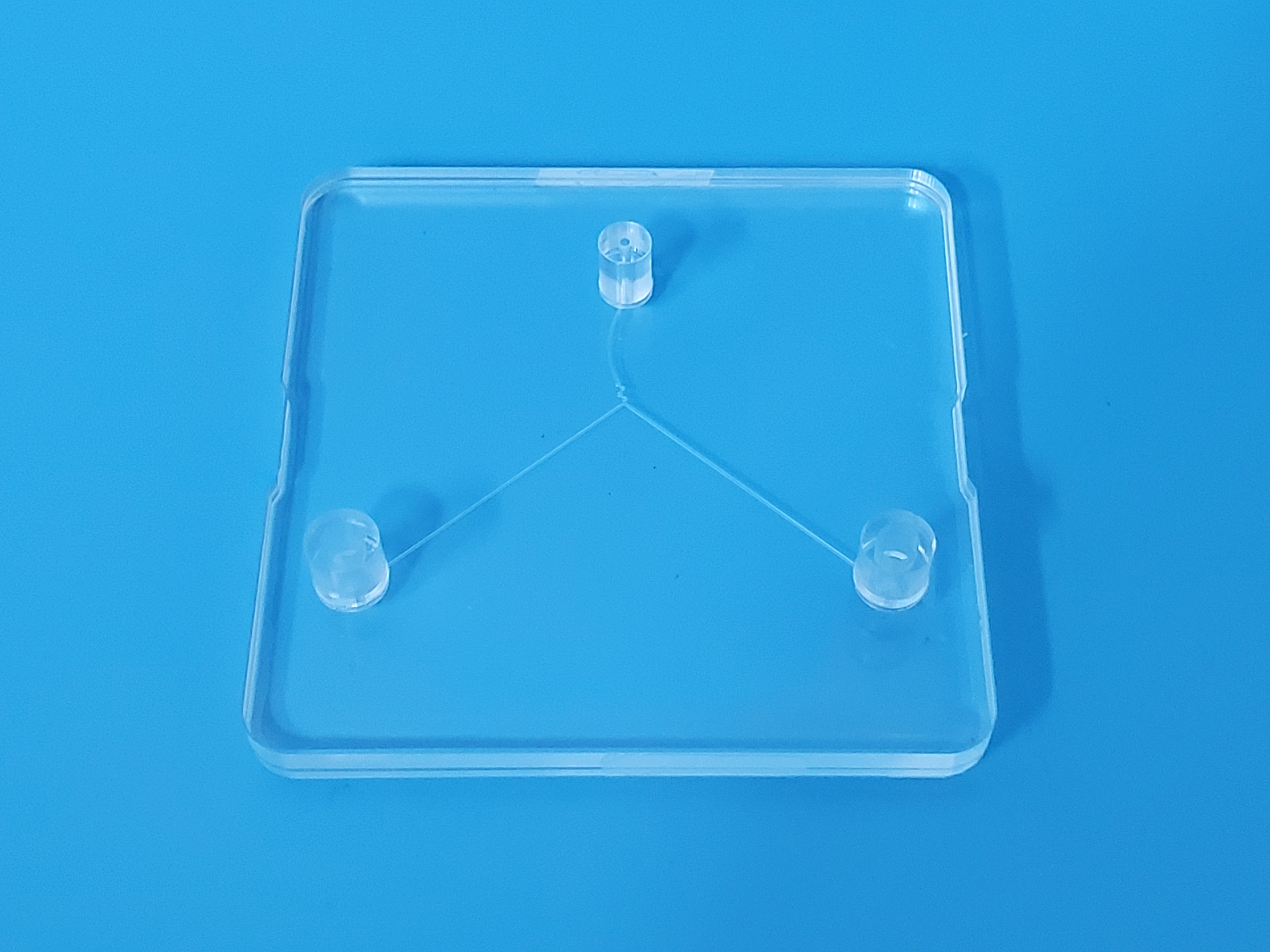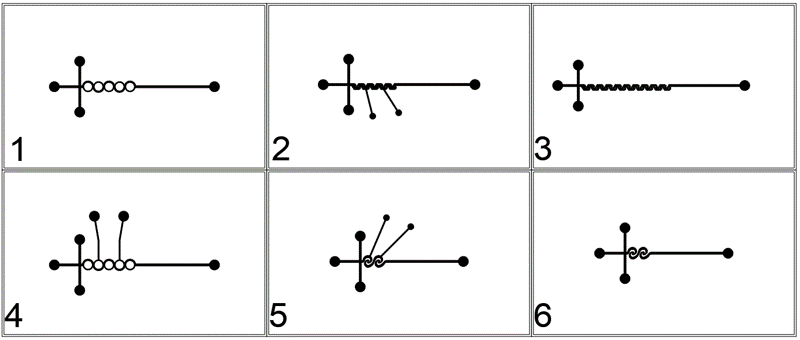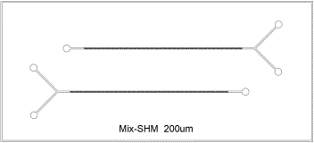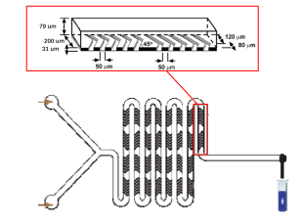Micromixer Concept
A micro-mixer is a microfluidic device that achieves rapid and homogeneous mixing of samples within a microchannel or microchamber, and is suitable for the adequate mixing of two or more different reactants under microscale conditions.
As an important application of microfluidics, micromixers have been widely used in engineering, biotechnology and medicine. For quite some time, micromixers have attracted a lot of attention in various fields such as biological and chemical processes, renewable energy and pharmaceutical industry for their low manufacturing cost, high specific surface area and fast response time.
Micromixer Classification
According to the working mechanism, the micro-mixer can be divided into two types: active micro-mixer and passive micro-mixer.
In active mixing methods, an external force is usually applied to promote cross contact between the fluids and improve the mixing quality, and the mixing process can involve different physical means.

Based on the type of interference, active micromixers can be categorized as pressure-driven, temperature-induced, electrohydrodynamic, dielectrophoretic, electrodynamic, magnetohydrodynamic, and acoustic.
Active micromixers tend to be complex in design, difficult and expensive to machine due to external intervening factors.
Passive micro-mixers are micro-mixers that do not require any external energy input, only a fluid pump and pressure drop to drive the flow, achieved by changing the geometry or placing barriers in the fluid flow path, with the aim of generating a secondary flow locally in the micro-channel to intensify the mixing.
The passive mixing process relies exclusively on diffusion and chaotic advection. Depending on the arrangement of the mixing phases, passive mixing can be further categorized into parallel lamination, tandem lamination, injection, chaotic advection and droplet mixing.
The main advantage of the passive micro-mixer is that no actuator is required. The simple passive construction is robust, stable in operation and easy to integrate.
Micromixer Design Requirements
In designing and evaluating the performance of mixers, the main concerns are the Reynolds number (Re) and the Peclet number (Pe). The Reynolds number characterizes the ratio of the inertial force to the viscous force of a fluid, and on a macroscopic scale, the flow is usually converted from laminar to turbulent when the Reynolds number is higher than a certain critical value.
However, turbulence cannot be achieved at the micro-scale because the Reynolds number in microfluidic devices is on the order of 1 or less, well below the critical Reynolds number. All micromixers operate in laminar flow and rely solely on diffusion.
Therefore, the general design requirements for micro-mixers are:
Rapid mixing time;
Small equipment area;
Integration capabilities in more complex systems.
Principles of Micro Hybrid Technology
Microfluidics-based micro mixer channel structure is usually in the micrometer scale, the inlet Reynolds number (Re) is very small, turbulent mixing is not easy to occur, the fluid flow structure is laminar, making the mixing process very slow and poor mixing effect. Therefore, it is necessary to change the fluid flow mode in the mixer to realize the efficient mixing of different fluids.
The basic mixing mechanism is as follows:
laminar shear
The introduction of secondary flow in the micro-mixer, so that the flow cross-section of the different streamlines between the relative movement, causing fluid micro-deformation, stretching and then folding, increasing the interface area between the fluid to be mixed, reducing the thickness of the flow layer.
Extended mobility
Due to a change in the geometry of the flow channel or due to the fact that the flow is accelerated, an elongation effect occurs, resulting in a further reduction in the thickness of the flow layer and an improvement in the mixing quality.
distributed mixture
Integration of static mixing elements within the micro-mixer reduces the thickness of the flow layer and increases the interfaces between the fluids through the splitting rearrangement and recombination effect of the fluids.
molecular diffusion
Molecular diffusion is the path to uniform mixing at the molecular level.
In conventional scale mixers, mixing at the molecular level is only meaningful if shear, extended and distributed mixing reduces the thickness of the stratum to a sufficiently low level.
In a micro-mixer, the equivalent diameter of the micro-channels can be as low as a few micrometers, and when the fluids to be mixed are in the same micro-channel, the path of molecular diffusion is greatly shortened, so that homogeneous mixing can be achieved in a very short period of time (milliseconds to microseconds) by molecular diffusion alone.
Relevant areas of application and examples of micro-mixers
Early research micro-mixers are mostly based on passive mixing, by patterning one or more surfaces of the channel, the fluid is mixed by laminar diffusion principle, the mixing time is long and poorly controllable.
With the continuous development of MEMS (Micro Electromechanical System) technology, the enhancement of the mixing effect of the passive mixing method has received more and more attention, and the research of passive micro-mixer is increasing.

Y-shaped and T-shaped micro-mixer is the most common, its structure is simple, mature processing technology, but it is affected by the molecular diffusion coefficient, the mixing intensity is lower. In the micro-mixer, the fluid flow is mainly laminar, and the mixing mainly relies on molecular diffusion, therefore, increasing the contact area between the fluids and reducing the diffusion path is the main way to improve the efficiency of micro-mixing.

This is compensated for by the emergence of herringbone ridge-shaped hybrid structures, where the presence of the ridge structure enhances the stretching and folding of the fluid interfaces, exponentially increasing the contact area between the fluids, resulting in a more extensive mass diffusion between the fluids.

The preparation of liposomes based on micromixers has become a new trend, due to the structural characteristics of micromixers, which allow small volumes of fluid reagents to be rapidly mixed in a highly controlled manner in microchannels, resulting in liposomes with high precision and reproducibility.
And the preparation of liposomes of different sizes, shapes, and physicochemical properties can be achieved by controlling the flow rate ratios of non-solvent and solvent solutions or by changing the configuration of the micro-mixer.
At the same time, since it allows controlled mixing of solvents in microseconds to milliseconds, which is a shorter time scale than the characteristic time scale for lipid aggregation through conventional methods (10-100ms), it helps to produce liposomes with smaller uniform sizes.
Biomedical field:
Gene Sequencing: The MicroMixer can be used to mix DNA samples with primers and enzymes for PCR (Polymerase Chain Reaction) amplification for fast, efficient gene sequencing.
Drug Delivery: In the drug development process, micromixers can be used to co-mingle drugs with carriers or drugs with cells to improve drug bioavailability and therapeutic efficacy.
Cell culture: Micro-mixers can be used to mix media, nutrients and cells for precise control and efficient transfer during cell culture.
Chemical field:
Catalytic reactions: Micro-mixers can be used to mix reactants and catalysts for efficient chemical reactions such as organic synthesis and catalyst testing.
Solution Mixing: In chemical synthesis and analytical chemistry, micromixers can be used to mix different solutions for rapid reaction of reactants and accurate detection of products.
Environmental monitoring and sensing field:
Water Quality Testing: The micro-mixer can be used to mix water samples and test reagents for rapid detection and analysis of water contamination.
Gas Sensing: Micro-mixers can be used to mix gas samples and sensing elements for rapid detection and analysis of gas composition.
Food and Beverage Industry:
Additive mixing: Micro-mixers can be used to mix food additives with food matrices to ensure homogeneity and stability of the food product.
Beverage Formulation: In the production of beverages, micro-mixers can be used to mix liquids with different ingredients for the formulation and flavoring of beverages.
About Us
DingXu (Suzhou) Microfluidics Technology Co., Ltd. is a high-tech enterprise dedicated to the field of microfluidics. We are committed to providing customers with comprehensive microfluidic solutions, including customized microfluidic chip development, surface modification, microfluidic chip processing equipment, and microfluidic instruments. Our team boasts extensive experience and technical expertise, continuously combining professional knowledge with innovative thinking to deliver high-quality solutions. We consistently prioritize customer-centric values, embrace self-challenges, and pursue excellence. Through professionalism, innovation, and collaboration, we aim to create greater value for our customers and contribute to a brighter future in the field of microfluidics.
Site Search
Recommendations
© 2025. All Rights Reserved. 苏ICP备2022036544号-1















